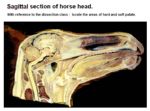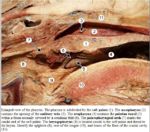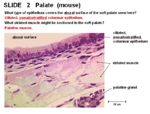Difference between revisions of "Soft Palate"
Jump to navigation
Jump to search
| Line 1: | Line 1: | ||
{{toplink | {{toplink | ||
| − | |||
|linkpage =Alimentary - Anatomy & Physiology | |linkpage =Alimentary - Anatomy & Physiology | ||
|linktext =Alimentary System | |linktext =Alimentary System | ||
| Line 30: | Line 29: | ||
**Insertion: soft palate | **Insertion: soft palate | ||
**Shortens palate | **Shortens palate | ||
| − | **Major innervation from vagus nerve ([[ | + | **Major innervation from vagus nerve ([[Cranial Nerves - Anatomy & Physiology|CN X]]) |
| − | **Minor from glossopgaryngeal nerve ([[ | + | **Minor from glossopgaryngeal nerve ([[Cranial Nerves - Anatomy & Physiology|CN IX]]) |
*Tensor velli palatini | *Tensor velli palatini | ||
Revision as of 15:03, 16 August 2009
|
|
Introduction
The soft palate (velum palatine) is located caudally to the hard palate. It is comprised of muscle and is involved in tasting food and in deglutition.
Structure and Function
- Muscle
- Contacts epiglottis caudally
- Very folded mucosa
- Striated palatine muscle
Musculature and Innervation
- Sensation and taste from glossopharyngeal (CN IX)
- Palatine muscle
- Tensor velli palatini
- Origin: near tympanic bulla on temporal bone
- Insertion: lateral aponeurosis
- Pharyngeal arch 1
- Mandibular of trigeminal (CN V3)
- Tenses soft palate
- Levator velli palatini
- Origin: near tympanic bulla on temporal bone
- Insertion: lateral aponeurosis
- Raises soft palate
- Major innervation from vagus nerve (CN X)
- Minor from glossopgaryngeal nerve (CN IX)
- Palatopharyngeus
Histology
- Respiratory mucosa - ciliated pseudostratified columnar epithelium on aboral surface
- Stratified squamous epithelium on oral surface
- Palatine salivary glands
Species Differences
Porcine
- Soft palate does not contact the epiglottis as the porcine soft palate is raised higher in the oral cavity than in other species
Equine
- Tight laryngeal cuff around the laryngeal entrance therefore the soft palate cannot be raised for long periods of time and thus horses are nasal breathers
- Laryngeal cuffing prevents vomiting
Canine
- As brachiocephalic breeds have a shortened skull length, the soft palate often obstruct air flow into the larynx causing breathing difficulties
Avian
- Birds lack a soft palate



